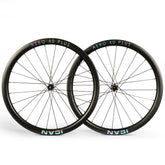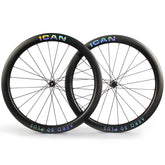How to choose the right wheel depth for your racing bike
What rim depth do I need for a racing bike? Answering this important question requires some research, especially in the age of carbon fiber. In the old days of alloy rims, rims were narrow and flat, and weight was the most important consideration for all cyclists. But then carbon fiber prevailed because the new miracle material was lighter and stiffer than metal.
It was also easier to shape, so designers spent many hours in wind tunnels perfecting the ultimate aerodynamic rim for road cycling. Streamlining has always been important on the road, as air resistance and energy requirements increase exponentially to achieve speeds above 15 mph. During competitions, average speeds of 50 kilometers per hour are reached, not to mention breakneck descents at twice this speed. Aero rims play an important role in such high performance.
At first glance, viewed from a distance, the modern professional peloton looks as if it is rolling on fat bike tires. But these days tires are still thin - 23 or 30 mm. A closer look shows that deep carbon rims give the impression of voluminous tires. The wide carbon rims are the result of intensive aerodynamic development and resemble a teardrop in overall cross-section, which is rounded off at the front end by the curved profile of a tire. An elongated teardrop-shaped cross-section has different wind protection properties than a flat rim. The cross section can be V-shaped, with a sharp edge at the junction of the spokes, or U-shaped, like a wine glass without a stem. There is also a hybrid form of both profiles, which is preferred by some aerodynamicists. The deeper the better, they say - and the ultimate depth is found on a disc wheel at the rear, where the rim profile ends at the hub, so to speak!
The pros and cons of deep rims
Let's take a look at the advantages and disadvantages of drop center rims. The benefits are obvious. They shave seconds off your best time against the clock or give you an advantage during a solo break. The greater the distance, the greater the energy savings and the less time required. They also give the bike more rigidity, resulting in more efficient power transfer to the pedals. Sure, they may be heavier than flat rims, but there's no denying that they cross the finish line first - in certain competitions, not all.
However, the advantages of deep rims also come at a price. The first is comfort. The extreme rigidity ensures a hard ride. Sometimes the rider feels like they are sitting on a jackhammer rather than a saddle, especially with the aggressive geometry of a time trial machine. That might be tolerable in a solo event lasting about an hour on flat roads - but no pro would want to use very deep rims in a one-day classic or national stage race. However, when cycling a triathlon on a straight, flat road and in calm weather, an 86mm deep rim is a big advantage.
And now the bad news. An ultra-deep carbon rim on the front wheel becomes a burden in gusty weather. Deep rims work wonderfully when the wind is coming from the front. But when the crosswind hits them broadside, they react like windmills, pushing the wheel to the side and going crazy with the steering. Performance suffers as the rider struggles to keep the wheel in a straight line. The lighter the driver, the more dangerous the effect. A petite lady should never use a deep rim in the front - unless the day is completely calm. A strong gust of crosswind could blow them off the road.
Flat rims
Flat rims are lighter, and even in alloy they are easier to accelerate because they have less inertia, which can give them a 1/100th of a second advantage in the last 200 meters of a sprint. On a track like a large mountain pass, where the field climbs at less than 15 km/h, aerodynamics don't matter. A flat, light rim helps the cyclist in his fight against gravity. However, it offers no advantage on the rapid descent, which usually follows a steep climb. On a route that ends at altitude, such as the famous Alpe d'Huez in France, a deep rim profile would be a disadvantage. But when fighting headwinds, it is far superior to a flat profile, even if it weighs more.
What rim depth is the appropriate size
Like so many other decisions in life, getting the right rim depth requires a compromise. For the club rider who likes to ride Gran Fondo, a rim with a depth between 45 mm and 55 mm is a good choice.
It represents the happy medium between the extremes in terms of comfort, aerodynamics and stability, especially in a densely packed peloton - even in crosswinds. Such a rim also provides greater durability for the rider who competes and trains with the same wheelset. The cyclist who lives and competes in a mountainous region might choose a flatter rim. If a heavyweight, dedicated competitor is looking for the ultimate rim for a flat course in calm conditions, he might opt for 86mm on the rear wheel - and slightly less adventurous if his course happens to be crossed by a crosswind.
How to choose wheels with suitable rim depth from ICAN.
ICAN offers performance wheelsets with a wide range of rim depths. This range of quality wheels is suitable for very specific purposes - and for cycling in general. Whatever the discipline a cyclist practices, the ICAN catalog offers a wheelset with a rim depth that will satisfy every customer. For mountaineers, there's the Aero 35 Disc for $655, as well as 50mm and 55mm versions. For the time trial pros, there's the Alpha 86 Pro for $540, and this series is also available for the peloton in 55, 50 and 40mm depths. A good all-around choice for beginners on a budget is the Alpha 50 Disc Pro wheelset for $485.






